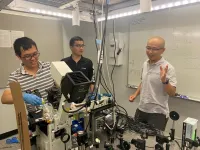(Press-News.org) HOUSTON - A phase II study led by researchers from The University of Texas MD Anderson Cancer Center found that treatment with atezolizumab and bevacizumab was well-tolerated and resulted in a 40% objective response rate in patients with advanced malignant peritoneal mesothelioma, a rare cancer in the lining of the abdomen. Responses occurred in patients regardless of PD-L1 expression status and tumor mutation burden.
Trial results indicated that the combination was safe and effective in patients with disease progression or intolerance to previous chemotherapy treatment. The study, led by Kanwal Raghav, M.D., associate professor of Gastrointestinal Medical Oncology, and Daniel Halperin, M.D., assistant professor of Gastrointestinal Medical Oncology, was published today in Cancer Discovery.
Malignant peritoneal mesothelioma (MPeM) is known as a rare but aggressive disease with historically poor survival and limited treatment options. Because symptoms most often go unnoticed, peritoneal cancer is usually diagnosed at a late stage. If left untreated, life expectancy is often less than a year.
"There is a grave unmet need for patients with peritoneal mesothelioma," Raghav said. "This study establishes a much-needed treatment option and represents an effort to encourage research for this rare disease."
One of the first trials for MPeM patients
Researchers estimate that 300-500 Americans are diagnosed with MPeM each year. MPeM usually follows the same treatment as pleural mesothelioma, a cancer of the lung lining, although there are significant differences between the diseases. MPeM is far rarer, understudied, has a weaker association with asbestos exposure, affects women more frequently, occurs at a younger age and is diagnosed more often at an advanced stage.
Treatment strategies are varied, but usually include optimal cytoreductive surgery, hypothermic intraoperative peritoneal perfusion with chemotherapy (HIPEC) or early postoperative intraperitoneal chemotherapy (EPIC). Patients with MPeM usually are treated following the recommendations for malignant pleural mesothelioma and most studies on chemotherapy drugs have been done for pleural mesothelioma, often excluding MPeM patients.
The National Comprehensive Cancer Network (NCCN) recommends first-line platinum chemotherapy for both mesotheliomas, but after disease progression there is no established treatment strategy or any Food and Drug Administration-approved treatments for advanced MPeM.
This single-center study is a multicohort basket trial for evaluation of atezolizumab and bevacizumab in a variety of advanced cancers. Atezolizumab is a type of immunotherapy drug called an immune checkpoint inhibitor that targets PD-L1, while bevacizumab is a targeted therapy that slows the growth of new blood vessels by inhibiting vascular endothelial growth factor (VEGF). This publication reports data for the 20 patients in the MPeM cohort. The median age was 63 years, 60% of participants were women and 75% self-reported that they had not been exposed to asbestos. Trial participants were 80% white, 10% Hispanic, 5% Black and 5% other.
Prior to enrolling in this clinical trial, patients who received standard of care chemotherapy progressed to next treatment at 8.3 months compared to 17.6 months with atezolizumab and bevacizumab on the study. The median response duration was 12.8 months.
Progression-free and overall survival at one year were 61% and 85%, respectively. The treatment was well-tolerated, with the most common events being hypertension and anemia.
"Patients treated on this regimen surpassed outcomes expected with conventional therapies," Raghav said. "This data shows that this is a reasonable treatment option and reiterates the importance of clinical trials for rare cancers to extend patient survival."
Biomarker analysis
Integration of biopsies before and during treatment established the practicability and the value of a translationally motivated approach in rare cancers. Using the biopsies, the researchers demonstrated that the clinical activity seen with this treatment combination did not correlate with clinically established biomarkers of response to immune checkpoint inhibition in other tumors.
The biomarker analysis determined that epithelial-mesenchymal transition (EMT) gene expression, which is a cancer state associated with a more aggressive biology, correlated with aggressive disease, treatment resistance and poorer response rates.
To define a tumor environment predictive of response to this drug treatment, researchers examined pre-treatment immune cell subsets using 15 available patient samples. They found that VEGF inhibition improves the effectiveness of immune checkpoint inhibitors by adapting the immunosuppressive tumor environment.
"I am very encouraged by the responses to this treatment, and I am hopeful that with additional research this will provide a better treatment option for these patients," Raghav said. "I am thankful for the patients who are willing to participate in clinical trials and help further our knowledge of rare cancers."
Additional trials with larger numbers of patients are needed to validate these study results, determine if this drug combination could be given as frontline treatment or improve surgical outcomes for these patients.
INFORMATION:
The authors would like to pay tribute to senior author, Gauri Varadhachary, M.D., for her efforts around this research and her mentorship. Varadhachary passed away June 5, 2021.
A full list of co-authors and their disclosures can be found here. The research was supported by F. Hoffmann-La Roche/Genentech and the National Cancer Institute (P30CA016672).
A consortium of modern slavery experts, led by the University of Nottingham, have assisted the Greek government to tackle a humanitarian crisis unfolding in the strawberry fields of southern Greece.
Using satellite technology to identify migrant settlements - a technique pioneered by the university's Rights Lab - and working with the Greek authorities, the experts then developed a decision model for which they could prioritise victims that were at highest risk.
Leading the study, the Rights Lab combined different data sources and methods to build a set of criteria measuring the extent of labour exploitation in a settlement. The academics then validated these criteria with a government agency and a Non-Governmental ...
The sun provides a daunting source of electromagnetic disarray - chaotic, random energy emitted by the massive ball of gas arrives to Earth in a wide spectrum of radio frequencies. But in that randomness, Stanford researchers have discovered the makings of a powerful tool for monitoring ice and polar changes on Earth and across the solar system.
In a new study, a team of glaciologists and electrical engineers show how radio signals naturally emitted by the sun can be turned into a passive radar system for measuring the depth of ice sheets and successfully tested it on a glacier in Greenland. The technique, ...
The treatment of many medical issues like abnormal gait and muscular disorders require an accurate sensing of applied pressure. In this regard, flexible pressure sensors that are simple, lightweight, and low-cost, have garnered considerable attention. These sensors are designed and manufactured through "additive manufacturing," or what is more commonly called "3D printing," using conductive polymer composites as their building blocks.
However, all 3D-printed pressure sensors developed so far are limited to sensing applied forces along a single direction only. This is hardly enough for real ...
CHAMPAIGN, Ill. -- Sharing ideas in an online learning environment has a distinct advantage over sharing personal details in driving learner engagement in massive open online courses, more commonly known as MOOCs, says new research co-written by a University of Illinois Urbana-Champaign expert who studies the intersection of marketing and digital environments.
Online learning engagement can be increased by nearly one-third by simply prompting students to share course ideas in a discussion forum rather than having them share information about their identity or personal motivations for enrolling, said Unnati Narang, a professor of business administration at the Gies College ...
RESEARCH TRIANGLE PARK, N.C. -- Army-funded research identified a new chemistry approach that could remove micropollutants from the environment.
Micropollutants are biological or chemical contaminants that make their way into ground and surface waters in trace quantities.
Using a pioneering imaging technique, Cornell University researchers obtained a high-resolution snapshot of how ligands, molecules that bind to other molecules or metals, interact with the surface of nanoparticles. In doing so, they made an unexpected breakthrough discovery. They determined that by varying the concentration of an individual ligand they could control the shape of the particle it attached too.
This approach could ...
When there is a gas leak in a large building or at an industrial site, human firefighters currently need to go in with gas sensing instruments. Finding the gas leak may take considerable time, while they are risking their lives. Researchers from TU Delft (the Netherlands), University of Barcelona, and Harvard University have now developed the first swarm of tiny - and hence very safe - drones that can autonomously detect and localize gas sources in cluttered indoor environments.
The main challenge the researchers needed to solve was to design the Artificial Intelligence for this complex task that would fit in the tight computational and memory constraints of the tiny drones. They solved this challenge by means of bio-inspired navigation and search strategies. The scientific ...
A new study finds forensics researchers use terms related to ancestry and race in inconsistent ways, and calls for the discipline to adopt a new approach to better account for both the fluidity of populations and how historical events have shaped our skeletal characteristics.
"Forensic anthropology is a science, and we need to use terms consistently," says Ann Ross, corresponding author of the study and a professor of biological sciences at North Carolina State University. "Our study both highlights our discipline's challenges in discussing issues ...
Super-thin carbon molecular sieve (CMS) membranes may not be best for separating industrially important chemical mixtures. However, ensuring the CMS film thickness is just right could enable more energy-efficient purification of chemical products, KAUST researchers have shown.
CMS membranes, as their name suggests, can purify mixtures of liquids or gases by permitting only certain molecules to pass through their subnanometer-sized pores. Currently, the chemical industry mainly uses heat-based processes such as distillation to separate product mixtures, but these processes consume about 10 percent of global energy output. "This situation is highly unsustainable," says Wojciech Ogieglo, a research scientist at KAUST. "We believe that a good ...
The premise of heated tobacco (HT) is simple: tobacco leaf is heated, never burnt, so avoiding many harmful by-products of combustion for the user. The exhaled 'mist' is correctly termed an aerosol, which is almost invisible and far less dense and pungent than the exhaled smoke from combustible cigarettes.
Another advantage of HT is that there are no 'side-stream' emissions to impact air quality (or disturb bystanders - these emissions form part of the ambient smoke that's often known as environmental tobacco smoke (ETS) or 'second-hand' smoke), because unlike a combustible cigarette there is no constantly burning tip. Our previous research suggests that, unlike cigarettes, using our Pulze heated tobacco device causes no negative impact on indoor air quality ...
Researchers have found evidence for an anomalous phase of matter that was predicted to exist in the 1960s. Harnessing its properties could pave the way to new technologies able to share information without energy losses. These results are reported in the journal Science Advances.
While investigating a quantum material, the researchers from the University of Cambridge who led the study observed the presence of unexpectedly fast waves of energy rippling through the material when they exposed it to short and intense laser pulses. They were able to make these observations by using a microscopic speed camera that can track small and very fast movement on a scale that is challenging with many other techniques. This technique probes the material with two light pulses: the first one disturbs it ...







